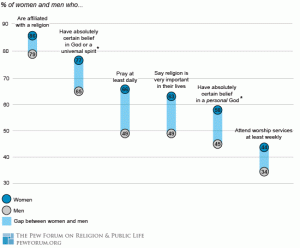Part of my research is focused on how the social sciences relate to “religion” and religious studies. More specifically, I spend time examining the sociology of religion. I look at stats, demographics, and polls. I look at rates of attendance, frequency of prayer, levels of “religiosity,” apostates (or the less religiously-loaded term “exiters”), and political outlooks. I also look at how bias this area of study is in favor of religion. One facet of this work that has always interested me, is the differences in “gender” and “sex” as they relate to religious beliefs and observances. Accepting the fact that there are spectrums of sex, gender, and identity, and the presence of difficult philosophical questions surrounding self-identification and the limits of labels, some really interesting facts and statistics crop up time and time again. In what follows I will lay out a couple of these interesting facts, along with some thoughts on them:
1. Women are more “religious” than men
In the literature and stats this notion is quite frequently cited. In 2009, the Pew Forum posted an analysis of the U.S. Religious Landscape Survey that was titled, “The Stronger Sex–Spiritually Speaking.” In this analysis, Pew Forum shows with a variety of measures that women are more “religious” than men. Some of the explanations given for this fact are that women spend more time at home raising children (thus, overseeing their religious development), women tend to be more relational or community-focused than men, or that women have a more developed ability to control their impulses (and so do not rashly “leave the faith or church”). I can see feminist criticisms of these points rising on the tips of our tongues. And yet, there is something to the fact that stats and polls show us over and over that women are more religious than men.
2. Catholic Countries have an average 15% lower female labor participation rate than Protestant Countries
Norton and Tomal point this out in an excellent article on religion and female educational attainment. The reasons for this can be numerous, but as Norton and Tomal say, “religion alone, therefore, can explain more than one-third of the cross-country variation in female labor force participation rates.” Many scholars connect this statistic with Max Weber’s notion of the “Protestant Ethic.” This “ethic,” Weber thought, was one in which Protestants’ material production and fiscal outcomes were indicators of one’s salvation. This pressure–the pressure to show one’s self to be materially “blessed” by God–played an important role in the development of modern Capitalism. Some of the other reasons scholars point out are cultural: in predominantly Catholic countries there are more traditional social pressures placed upon women to stay at home and raise children. Whatever the case, this is an interesting stat.
3. Religiosity Contributes to more unequal Gender Outcomes
Surprise! Norton and Tomal conclude this in their study of the World Values Survey. This confirms what the Global Peace Index has been reporting for a while: countries with the highest levels of religiosity (Pakistan, Sudan, Somalia) have higher rates of crime, inequality, civil wars, lack of education, etc., while places with lower levels of religiosity (Iceland, Denmark, New Zealand) tend to be more stable, peaceful, and equitable. This is confirmed once again in the wide-breadth of research done by Steven Pinker in his “The Better Angels of Our Nature: Why Violence Has Declined” (for brief responses to his critics, see this). To put it bluntly: less religiosity means more equality for women.
4. Secular persons share the same voting patters and values as women
Phil Zuckerman, professor of Sociology at Pitzer College (and one of my advisors), says, “Recent studies show that secular individuals are much more supportive of gender equality than religious people, less likely to endorse conservatively traditional views concerning women’s roles, and when compared with various religious denominations, ‘Nones’’ possess the most egalitarian outlook of all concerning women’s rights.” All the statistics one can dig up show this over and over. It is hard to find an atheist Republican (around 1 out of 10), and a female one (around 1 out of 4), but it is easy to find socially liberal atheists and women.
5. 10-12% of Senior or Sole Ordained Leaders are Women
This may not shock you, but it certainly is interesting. Even now, in the second decade of the second millennium C.E., women make up such a small amount of religious leaders. In both the Faith Communities Today Survey and the National Congregations Survey this percentage is demonstrated. Per denomination, the numbers of women leaders are highest in the Unitarian Universalist Association (30%) and the United Church of Christ (25%), and lowest in the Free Methodist Church (1%) and the Southern Baptist Convention (4%).
The question now is, what do we think about women and religion given these facts and stats? What should we do with them?
Orignal post at Feminism and Religion here.














